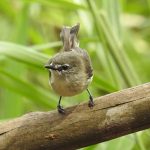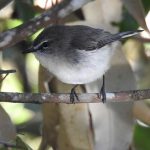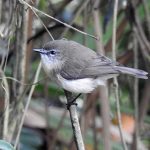BROWN GERYGONE
The Brown Gerygone is found throughout much of eastern and south-eastern Australia, including coastal and inland areas. They are commonly found in forests, woodlands, heathlands, and coastal scrub habitats.
These birds are quite small, measuring around 10-12 cm in length. They have brownish-grey plumage on their upperparts and are paler on the underparts. The tail is often held upright.
Brown Gerygones are known for their melodious and repetitive songs. They have a varied and tuneful call that is often described as a series of melodious whistles or trills.
Their diet primarily consists of insects and other small invertebrates. They forage in the tree canopy, gleaning insects from leaves and branches.
During the breeding season, Brown Gerygones build a small cup-shaped nest, often suspended from the outer branches of trees. The female usually lays two or three eggs, which are incubated by both the male and female. Once the chicks hatch, both parents share the responsibility of feeding them.
While they are primarily sedentary, some populations of Brown Gerygones may undertake seasonal migrations in response to changes in food availability.
These birds are highly adaptable and can be found in a variety of habitats. They are often observed in urban and suburban areas, as well as in more natural settings. In addition to Brown Gerygone, this bird is also known by other regional names, including Brown Warbler and Brown Flyeater.
Brown Gerygones are often seen in pairs or small family groups. They are active birds and are known for their acrobatic flight as they flit through the trees in search of food.



